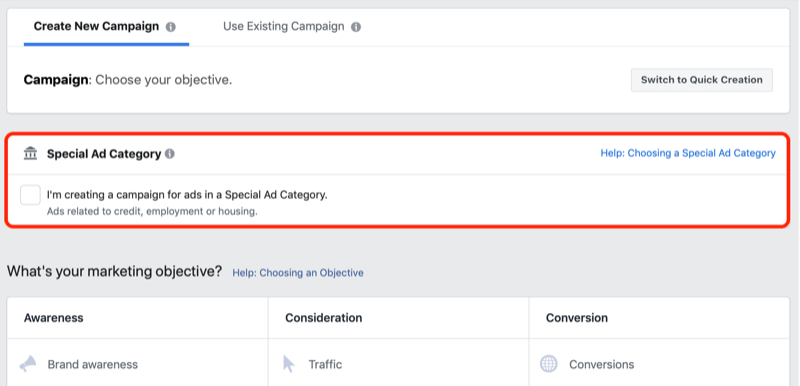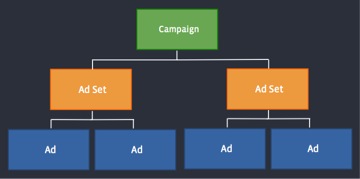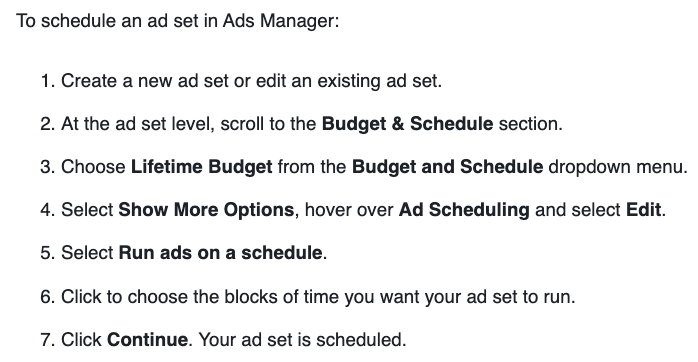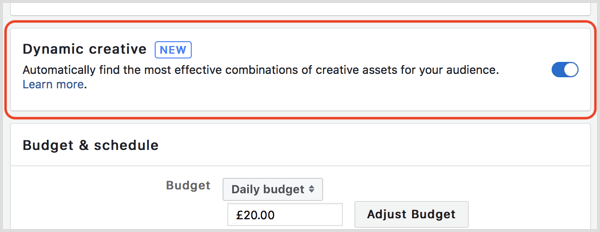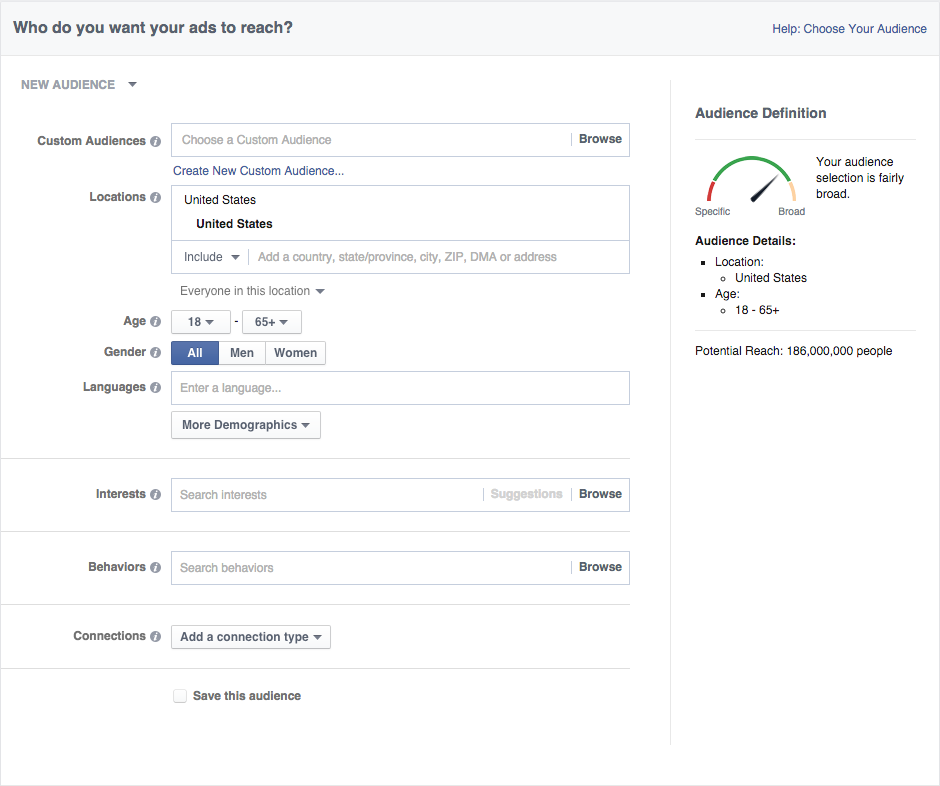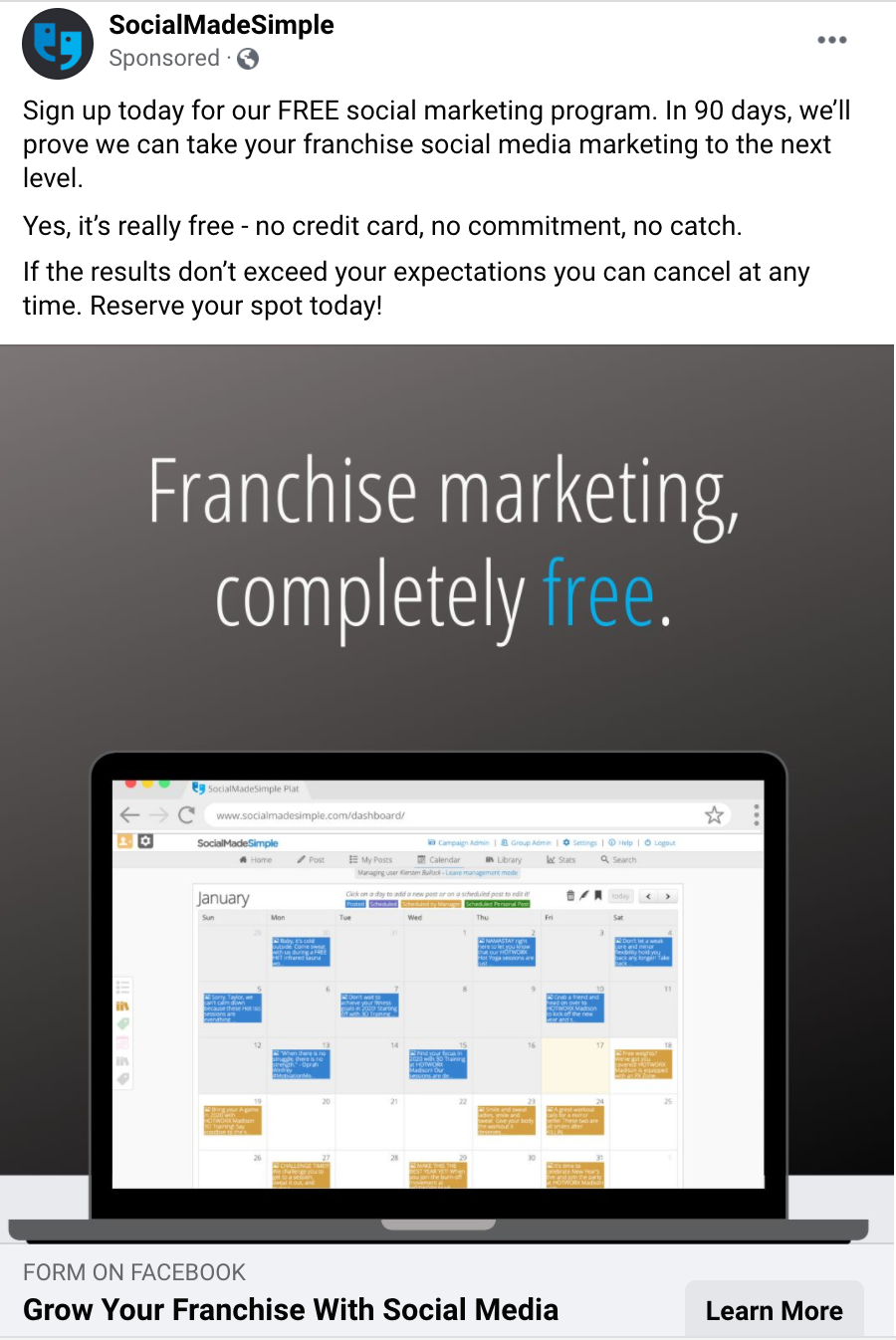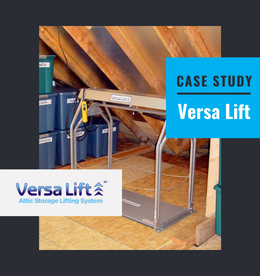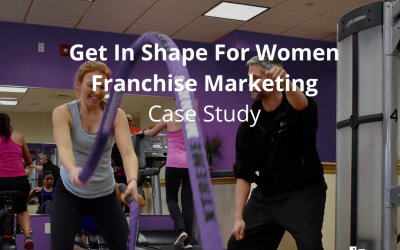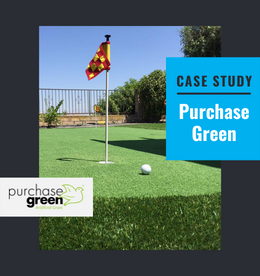How To Get Started With Facebook Ads

I’m going to spare you the spiel on why you should be running Facebook ads and just ask that you trust me when I say – it works (& continues to work for millions of businesses every day).
To get started with Facebook ads, you’re going to need a Facebook business page set up before diving into all the magic that happens in Facebook Ads Manager. There is no need to panic if you don’t yet have a Facebook business page: here is a step-by-step guide to creating a Facebook business page.
Facebook advertising consists of three components: a campaign, an ad set, and the ad. At the campaign level, you will choose the objective that best matches the action you want customers to take and set your budget (either daily or lifetime). The ad set level is then where you can select a start/end date and have the flexibility to get creative with targeting your audience. Last but certainly not least is what customers actually see… the ad itself. The ad set is made up of ads where you can include an image or video, create the primary text, write a headline, and more.
1. Facebook Ad Campaign
Objective
With every campaign, there are three objective categories to choose from:
- Awareness: brand awareness or reach
- Consideration: traffic, engagement, app installs, video views, or lead generation
- Conversion: conversions, store traffic, or catalog sales
Your campaign objective is based on the action you want someone to take when seeing your ad. Awareness objectives generate interest in your business. Consideration objectives drive people to seek more information about your business. Conversion objectives encourage people who are interested in your business to purchase the product or service.
If you want to send people from Facebook to your website, for example, you can use the traffic objective to encourage people to learn more about your business by visiting your website! Listen to the SocialMadeSimple team give a quick tip for successful ad campaigns.
Special Ad Categories
In an effort to avoid discrimination, Facebook introduced the Special Ad Category that limits the audience targeting options for ads in the following categories:
- Housing: Promoting or directly linked to housing opportunities or related benefits such as sale or rental of a home or apartment, homeowners insurance, mortgage insurance, and mortgage loans.
- Credit: Directly linked to a credit opportunity such as credit card offers, auto loans, personal or business loan services, and mortgage loans.
- Employment: Promoting employment opportunities such as part- or full-time jobs, internships, or professional certification programs.
- Social Issues, Elections or Politics: Made by, on behalf of, or about a candidate for public office, a political figure, or a political party; or promotes a social issue that may influence the outcome of an election.
I know restrictions on audience targeting sounds like a red flag, but these changes were put in place to protect against Facebook’s long history of discrimination in these areas. Instead of creating a custom audience, ads falling under the Special Ads Category are restricted to what is called a Special Ad Audience. Facebook shows the ads to people who match the online behavior of current customers rather than targeting by demographics such as age, gender, or interest.
Aside from targeting restrictions, these ads are just like any other!
Budget
With every Facebook ad campaign, you have two types of budgets to choose from:
Lifetime budget: This allows you to set a certain amount to spend over the lifetime of an ad set. A lifetime budget is typically best suited when there is more flexibility around the amount spent per day and a hard spending cap that you don’t want to go beyond.
Daily budget: This allows you to tell Facebook the average you would like to spend per day. A daily budget is a great choice if spending around the same amount each day to get consistent daily results is a priority for you.
2. Ad Set
Let’s break it down: ad campaigns are made up of ad sets, and those ad sets consist of ads. The ad set level is where you can tell Facebook who to show your ads to, where to run them, and when to run them. Keep in mind that all settings applied to the ad set will be applied to all ads in that set.
Setting a Schedule
When creating your ad set, you can set a specific start/end date and time that you want your ads to be shown (ads must be running for at least one hour). Ad scheduling is only available with a lifetime budget. Therefore, if you have set a daily budget at the campaign level, a new campaign will be required. Since you have the option of either running your ads immediately or on a specific date in the future, there are some things you should know.
Once your ads are scheduled, they will then get reviewed and approved (or rejected) by Facebook. If you choose to start running the ads immediately, they will automatically begin running once approved. If you choose to have your ads start running on a specific start date, you can either set a schedule while creating the ad set or create your ad in advance to then turn it off and then back on whenever you would like them to start running.
Dynamic Creative
In those moments where you don’t have confidence that your ad creative will perform well with certain audiences, dynamic creative is an effective optimization tool that allows you to create personalized creative variations for each user that views your ad.
How does this work? As we will soon cover, ad creatives consist of several elements: call-to-action (CTA), images, videos, descriptions, and titles. Dynamic creative takes these creative elements and optimizes them to deliver efficient results by pairing elements based on the user’s susceptibility to click on the ad. Facebook automatically creates multiple ad variations from the different elements (CTA, images, videos, titles, etc.). Based on the ads’ performance, Facebook continues to show the top-performing ads more frequently.
Targeting Your Audience
At the ad set level, you have the opportunity to reach your ideal customer by building your target audience based on interests, online behavior, and demographics such as:
- Age (18 – 65+)
- Gender
- Language
- Location (people living in, recently in, or traveling to):
- Zip code
- City
- State
- Country
If that isn’t enough, you can also target based on your audience’s interests, some of which include:
- Business and specific industry
- Entertainment
- Fitness and wellness
- Food and drink
- Hobbies and activities
- Shopping and fashion
There are primarily three types of audiences in Facebook Ads Manager:
1. Custom audiences
Reaches people on Facebook who have already interacted with your business in the past. A custom audience can be created either by a customer file, website traffic, app activity, or engagement on Facebook. A customer file allows you to create a list matching your customers with Facebook users. Website traffic allows you to create a list based on people who have visited your website. App activity creates a list of people who have taken a specific action on your app. Engagement on Facebook creates a list of people who have engaged with content on your Facebook page. You can choose to include or exclude custom audiences from your targeting.
2. Lookalike audiences
Reach new people on Facebook who are the most similar to your most valuable audiences. To create a lookalike audience, you first need to have created a custom audience and select the country/countries where you’d like your ads to be shown. Facebook then identifies similarities in qualities such as interests or demographics and creates a list of people who are most likely to have an interest in your business. You can choose to include or exclude lookalike audiences from your targeting.
3. Saved audiences
Build target audiences using Facebook’s interests, online behavior, and demographics. Once you’ve built your target audience, you can then save it and use it, again and again, to make it easier than ever. All targeting will be saved besides location, so don’t forget to enter the audience’s location(s) every time!
Detailed Targeting
The targeting capabilities don’t stop there. Through detailed targeting, you can refine your targeting by including and/or excluding certain people from your audience based on demographics, interests, and behaviors.
- Demographics: Education (HS degree, Masters, etc.), Life Events (Marriage), Relationship, Work, Generation.
- Interests: Music, Hobbies, Business, Fashion, etc.
- Behaviors: How users interact online, Engaged shoppers, Mobile device user, and more.
3. Facebook Ad
Alright, this is the part you’ve been waiting for… creating the ad that your audience actually sees! At the ad level, you will first decide which type of ad creative is best:
- Images (JPEG, png)
- Videos (Promotional, GIF, MP4)
- Carousel Ads (1-10 images or videos in one ad)
- Collection Ads (Displaying items from an online shop)
*Don’t forget you can have multiple ads in one ad set
Once you have your image or video selected, you can go down the checklist of the remaining elements of a Facebook ad creative:
- Primary Text: This is the most important part: the moment to let your business shine. Aside from the creative itself, the primary text is the main place your customer will look for information on whatever it is you’re promoting. A helpful tip for capturing your audience’s attention is including a time frame – using words like “today” or “now” does the trick!
- Call to Action (CTA): The call to action button on your ad will indicate the action you’d like the customer to take. If your objective is for the user to book an appointment, then your CTA would say Book Now. Let’s say you run an e-commerce business and you want people to shop on your website – then I’d say Shop Now is your best bet. Choose a CTA based on your business goals, and you’re good to go!
- Headline: The headline appears below the ad visual and can be up to 40 characters long. According to Hubspot, the key to creating powerful headlines is making them customized, clear, and concise.
- Description: Last chance to add some final specifications! The description is where you can describe to your audience what they will gain by clicking the call to action (and all in under 30 characters).
- Optional: Display Link, Description
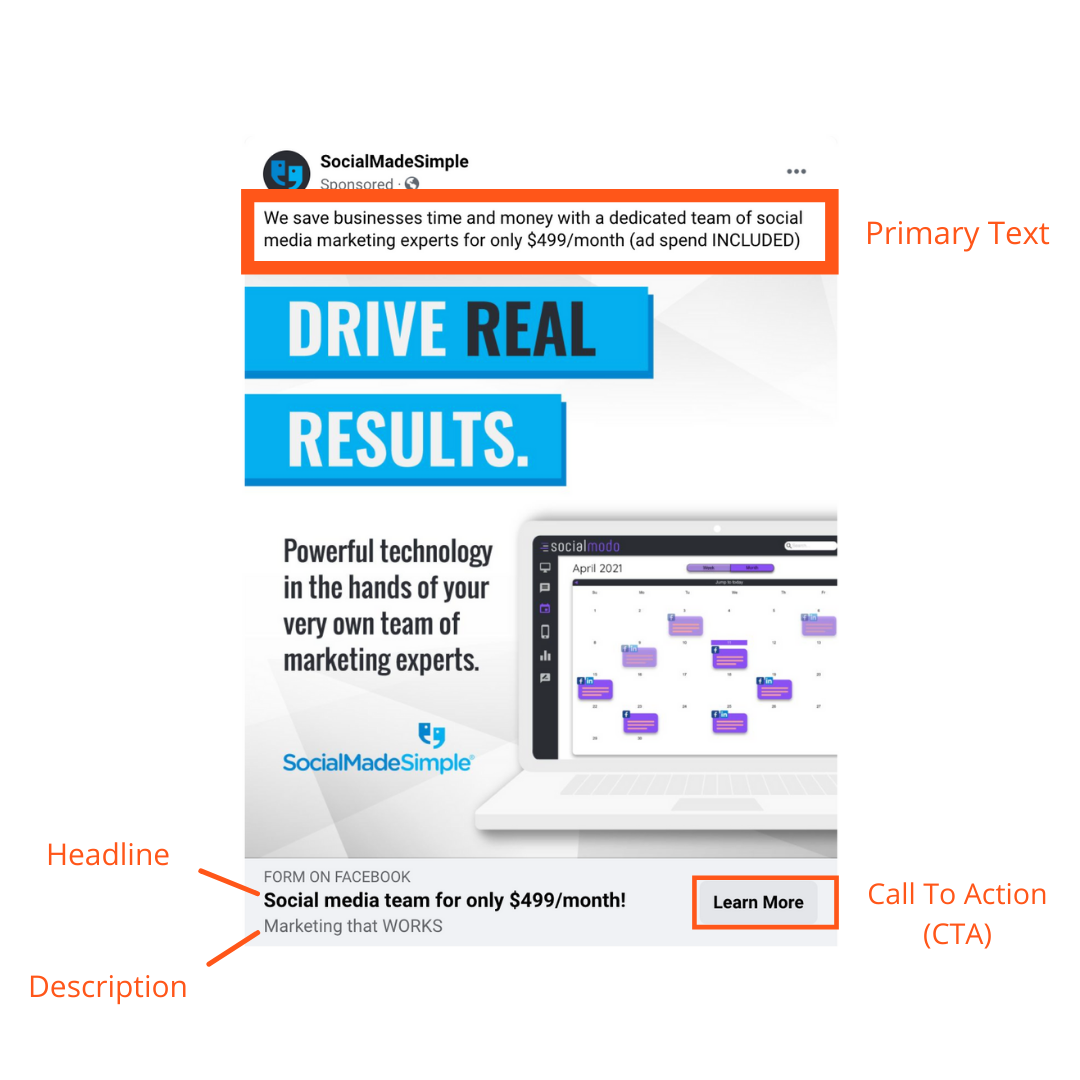
Ready to get started with Facebook ads?
There are many moving parts, Facebook do’s & don’ts, and a revolving door of new features to keep up with, so if you still feel a bit unsure of how to get started, just know you’re not alone! This is why businesses of all industries and sizes rely on social marketing experts for Facebook advertising and much more to guarantee maximum results.
For more insight on getting started with Facebook ads, watch this quick video from Facebook and schedule a call with the SocialMadeSimple team to learn how we can drive real results for your business through Facebook advertising.
Client Success Stories
Versa Lift Attic Storage Systems’ Social Media Advertising Campaigns Reach Over 2 Million Users on Facebook & Instagram
Versa Lift by Byers Products Group is one of the best home storage systems on the market and has been driving results with SocialMadeSimple since 2018. Check out their case study to see how SocialMadeSimple’s Social Media Advertising campaigns have reached over 2 million people.
Get In Shape For Women Franchise Case Study
Get In Shape For Women participated in a 90-day marketing pilot program to generate customer leads and increase brand awareness affordably.
Purchase Green Artificial Grass Generates 25 Booked Appointments In 90-Day Franchise Marketing Pilot Program
Purchase Green is an artificial grass franchise that completed a 90-day Franchise Marketing Pilot Program with SocialMadeSimple… at zero cost! See how their lead generation ad campaigns effectively generated over 100 leads & boosted their brand awareness.

